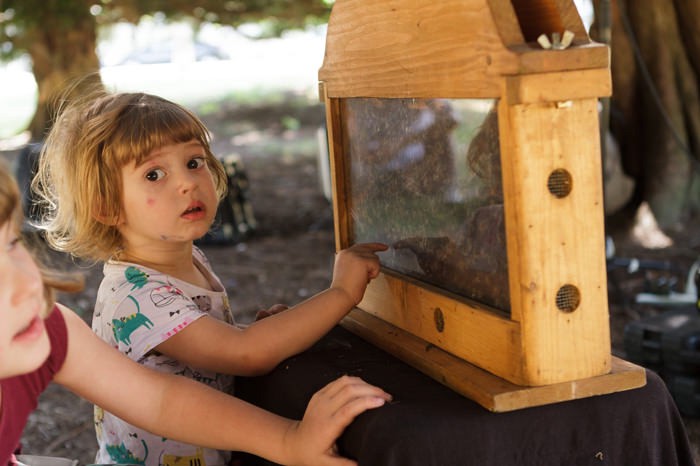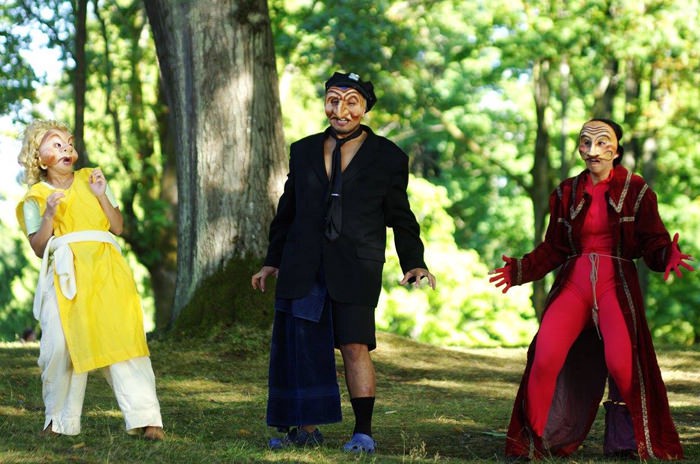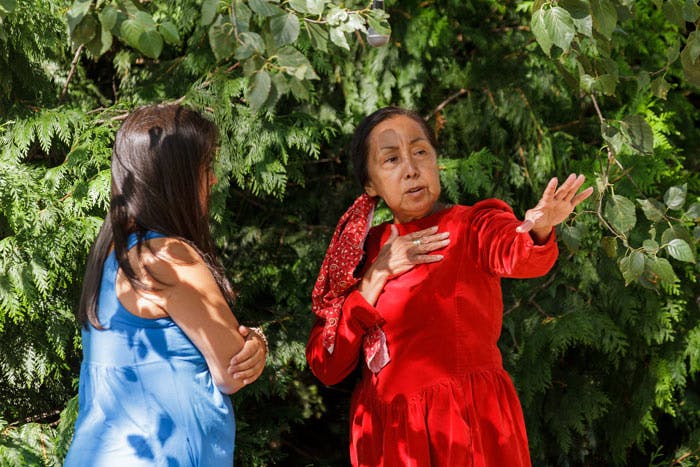Growing the Vines Festival: A Q&A with Heather Lamoureux
Vancouver’s eco-arts festival brings activist performance to the people.
Tsimshian and Haisla artist Crystal Smith (pictured, left, with Kat Zucomulwut Norris) created Saving Mother for the 2017 Vines Art Festival. On August 17 and 18 she’ll present a new commission as part of this year’s Resilient Roots program.
The fourth edition of Vancouver’s Vines Art Festival opens today, setting up in parks and public spaces around the city through August 19th. Over the course of the next 12 days, festival-goers can experience outdoor music, dance, poetry, sound and fibre-art installations, the first-ever Unsettling Ceremony, and so much more besides, in venues from Kits Beach and Granville Island, to North Vancouver’s Harmony Garden and the festival’s home park, Trout Lake. All for free! Asparagus sat down with founder and artistic director Heather Lamoureux to learn about the festival’s origins, growth, and future. (This interview has been edited for length and clarity.)
Jessie Johnston: What is the Vines Art Festival?
Heather Lamoureux: The Vines Festival brings together artists and activists to create work on the land, in public space. It’s a 100% free festival throughout Vancouver’s parks: Trout Lake, CRAB Park, Kitsilano Beach, Trillium Park, the Roundhouse Community Centre, and even Granville Island this year. We program work that’s at the intersection of activism and the arts, and typically speaks to environmentalism and social justice. It’s multi-disciplinary: dance, music, theatre, spoken word, and visual art installations, and things that mix up all those things.
This is the festival’s fourth year. Tell me about putting on the first one.
The first festival was quite small, it was just an afternoon in Trout Lake Park. It was self-fundraised, and with a group of artists I had a relationship with. It was a small afternoon of sharing public performance in public space, and grew from there. It didn’t reach the same level of social and environmental justice that we are now. And now we’re reaching into many different communities, instead of a small community where I knew everybody. It’s grown in that I don’t know everyone there, which is nice.
What has the journey been like since that first festival? How did you get where you are today?
After that afternoon we had a base — some pictures and video — which was helpful to put across our idea. From there we got one grant from the City, so we expanded to four days. We partnered with the Vancouver Park Board artists in residence, artists that work out of a park and connect with that community.
The Resilient Roots program commissions Indigenous emerging artists to create new works, and is the centrepiece of the festival.
The next year we started the Resilient Roots program, which commissions Indigenous emerging artists to create new works for the festival. That became the centrepiece of the festival. Some of these commissioned projects will have a life after the festival, so a big intention past presenting the art is supporting artists to create connections with each other and start new works that they can take past the festival.

Vines founder and artistic director Heather Lamoureux
Tell me more about Resilient Roots.
This is the second year. Last year it was about bringing artists and activists together. There were some Indigenous folks and some non-Indigenous folks, and they worked together. But this year we decided to focus just on working with Indigenous artists. So myself and Senaqwila Wyss are co-coordinators, and then we have a group mentor, Sara Cadeau, who’s also running an Unsettling Ceremony on the 19th.
We found six young artists that have a practice already, but could use more support: Alex McCallum, Jaye Simpson, Jaz Whitford, Mitchelos Touchie, Valeen Jules, and Crystal Smith. They all have mentors that are supporting their projects, and they’ll be presenting these new commissions on August 17 and 18 at Trout Lake. A lot of them work on front lines, and they’re creating all the time as it is, so it’s really about giving them more resources so they’re more supported in the work they’re doing.
The idea is to create a ceremonial space, and to then question how we as settlers can unsettle ourselves.
What’s an Unsettling Ceremony?
This is the first one, so I’m not 100% sure yet, but we will find out! Last year we had a conversation about art’s role in decolonization. It’s similar to that, but we’re changing the format. The idea is to create a ceremonial space, led by Sara, and to then question how we as settlers can unsettle ourselves, [find] different ways to be allies. There will be really practical steps and tools shared, and we will have witnesses from the Coast Salish nations. A witness is someone who hears what happens and then takes that back to their community. And we’re hoping everybody who is part of the circle takes that knowledge back. [Squamish artist and ethnobotanist] Cease Wyss will be one of the featured speakers.

Vancouver-based inclusive dance company, All Bodies Dance, performed at the 2017 Vines Festival, and returns to this year’s festival with performances on Granville Island (August 8) and at the Roundhouse Community Centre (August 10).
Describe some experiences people can have at the festival this year.
One event that’s new to the festival is we’re doing a three-day stay at CRAB Park. On Monday the 13th, there’s going to be a free dance class, and then a circle discussion. On the 14th and 16th, we’re doing Songs on the Ocean. An̓usáyum̓, which means “two berries” in Squamish, will be singing in their language. They have such beautiful voices. It’s very heartwarming, it makes me cry.
And then we’ll have Eddy van Wyck leading a program called Stem Mother Tongue around the theme of relating mental health to environmental justice. How the land can be healing, but at the same time the work can be really draining, and can cause anxiety and depression. We’re talking about how you can use your voice for healing, and there will be a concert around that.
The land can be healing, but at the same time the work can be really draining, and can cause anxiety and depression.
Then, to finish it all off, Kimmortal, Missy D, and Immigrant Lessons are coming together. Kimmortal and Missy D are two female MCs, and Immigrant Lessons is an all-people-of-colour hiphop [dance and art] group. They’re going to create this scene in CRAB Park, and sing from all these different places. It sounds like it’s going to be really, really exciting.
The other day that’s not to miss is Saturday [August 18] at Trout Lake, which just has a lot of everything. Good for kids, good for any age, really. We’ll have ASL interpretation for that day as well. It features Resilient Roots, but also has many different artists: a taiko group; part of our youth program is presenting that day; other dancers; Old Soul Rebel singing. There’s lots of interactive stuff for kids to do. You can entertain your children and be entertained yourself, all at once in one spot.

The festival’s signature event at Trout Lake (Saturday, August 18) will feature interactive experiences and performances for all ages.
What’s the youth program?
We started it this year. We brought in some amazing Vines artists to teach workshops to nine youth, and then they’re all creating their own projects in pairs or trios. We’re coaching them through finding what issue they want to speak to, and then helping them find a way to do that. One of them is called Accessibird, by Tom. So Tom is pointing out things that are un-accessible — that most people who are able-bodied wouldn’t notice — via these bird signs. So you have to find them. I’m excited.
Why is the festival free?
My intention was to bring thoughtful art that carries messages and stories to a public that wouldn’t go to a theatre. Bringing that work outside. In order to get that audience, it’s important that it’s free and accessible. I believe that it’s crucial we share the messages these artists are giving. Of course there are always barriers to getting anywhere, but to take away as many of those as possible, that’s what I’m passionate about.
How do we change the overpowering narrative of so-called-Canada’s art scene, and move around resources to support other folks?
What life experiences made you passionate about these ideas?
Vines’ growth and my growth as a human have been on track with one another. I went to school for dance; I value the strength of the body and the importance of putting certain bodies in certain places.
I just finished an expressive arts therapy/movement therapy program with Anna Halprin, who’s one of my big mentors. She’s 98. That’s really informed a lot of what I do: the importance of giving space for people to explore what’s going on inside them in relationship to their environment, and then bring that forward for other people to witness. In the United States, she was the leader of community-based dance. She’s worked with people with AIDS, and all sorts of awesome projects. That thought-process and practice is inspirational to me, and I value finding people in all these different communities and bringing them together.
There’s a lot of status around who gets grants and who gets a platform, just because they’re privileged and they’re in the right place. So I’m interested in seeing how can we shift that, and give other folks support to navigate that system, if they want to. That’s something I’m passionate about: how do we change the overpowering narrative of so-called-Canada’s art scene, and move around resources to support other folks?

The New (to) Town Collective’s parade will roam the Trout Lake site on August 18.
Why doesn’t the festival stay in one place? Moving around must be hard.
If we go different places, we reach different communities. A lot of the festival’s intention — though of course we want audience to come to it — is to plop down somewhere people are already, and share with them. Those found audiences are really exciting.
Although it seems hard to move from place to place — it is hard to set up all the permitting, all that stuff takes time — it’s not that difficult because we don’t have much. There’s no stage, it’s just bringing the sound equipment. And you have to take it out anyway because it’s a public space and you’re not going to leave expensive speakers. So it’s not as difficult as for an event where they bring a lot of stuff. But that’s a good question, I think about it.
This festival couldn’t hold its values and grow into this huge thing that thousands and thousands and thousands of people come to.
What do you imagine for the future of the festival?
I would love to have a few folks [working with me] year-round, so it’s not so much of my voice. I’ve said from the beginning, this festival couldn’t hold its values and grow into this huge thing that thousands and thousands and thousands of people come to. That’s not the intention. The intention is to build deep relationships with the people that do show up and make everyone feel like they’re part of the family. I don’t want it to get any bigger.
I think building relationships around commissioning works, and supporting those artists past the festival, that’s something I’m interested in. Going to different places in BC and bringing highlights from Vines, and connecting with other communities. That would be a whole other set of challenges, but that’s something I’m interested in.
And developing these youth programs, maybe even an elders program. There’s a lot of support for youth coming up, through the government. And sometimes I feel like, “What about everybody else?” They need help too.
